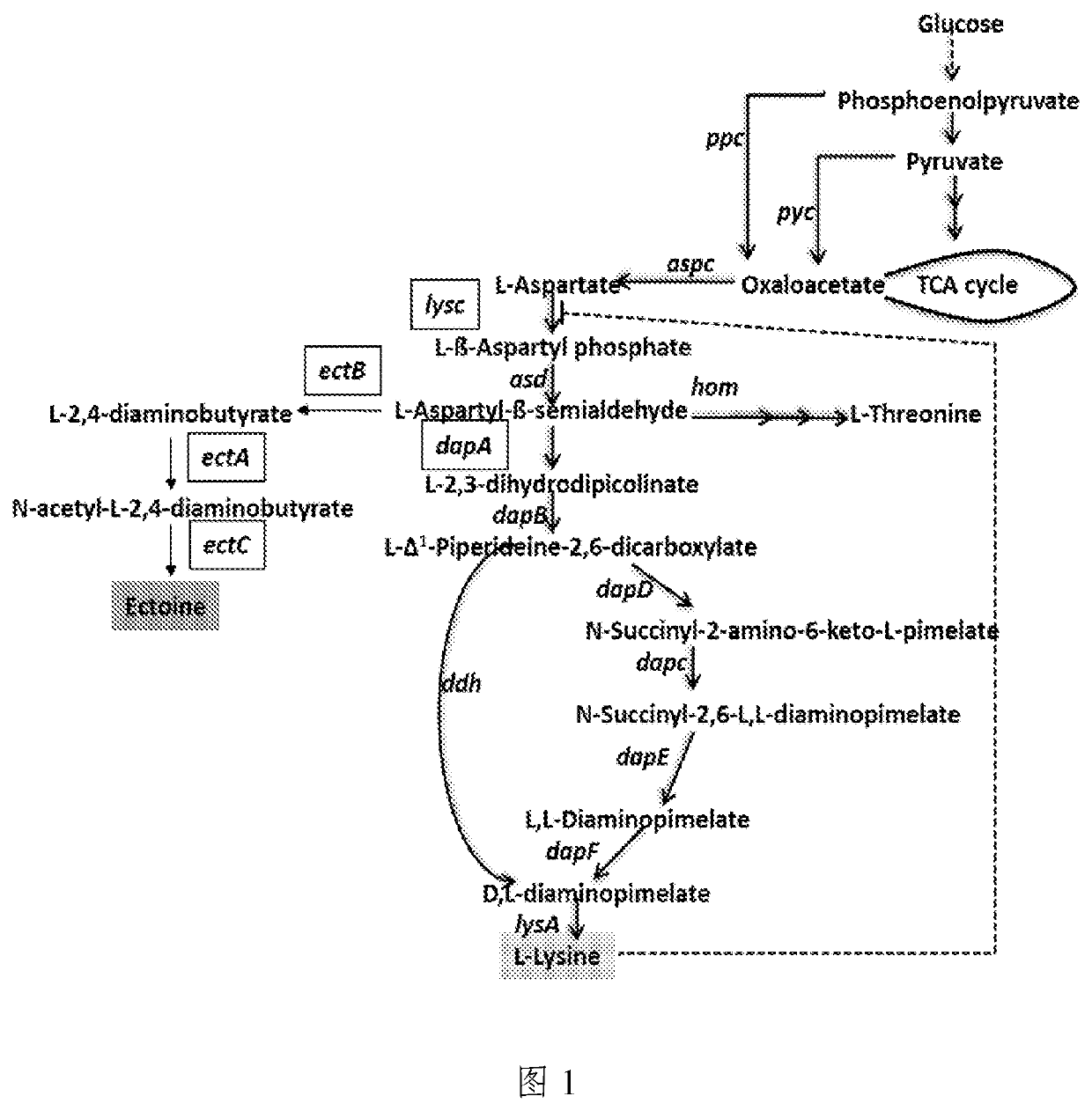Method for producing tetrahydropyrimidine by fermenting recombinant corynebacterium glutamicum
a technology of corynebacterium glutamicum and tetrahydropyrimidine, which is applied in the direction of transferases, bacteria-based processes, lyases, etc., can solve the problems of increasing production costs, high production prices, and complicated separation processes, so as to simplify the post-extraction process, reduce the cost of feedstock, and simplify the fermentation process of ectoine
- Summary
- Abstract
- Description
- Claims
- Application Information
AI Technical Summary
Benefits of technology
Problems solved by technology
Method used
Image
Examples
example 1
ssion of the Aspartokinase Gene lysC with Feedback Inhibition Relieved
[0029]The direct synthesis precursor of ectoine is aspartate, and the first enzyme, aspartokinase, in the synthesis pathway of aspartate to ectoine is feedback inhibited by lysine and threonine. Therefore, the present invention first relieved the feedback inhibition to the enzyme by lysine and threonine via introducing a site-directed mutation Q298G into the aspartokinase gene, and a strong promoter P1 was inserted before the gene (lysC) (the sequence is: 5′-ggtgcacaaagCAAAAGCTGGGTACCTCTATCTGGTGCCCTAAACGGGGGAATATTAACGGGCCCAGGGTGGTCGCAC CTTGGTTGGTAGGAGTAGCATGGGATCC-3′) (SEQ ID NO: 4) to enhance the expression of the gene. The specific process is as follows:
[0030]PCR was performed by using the genome of Corynebacterium glutamicum MB001 (Baumgart M et al, Appl Environ Microbiol 79: 6006-15 (2013)) as a template and the primers lysC-1-F (aggaaacagctatgacatgattacgtttcgcccagaaccaagtagcc) and lysC-1-R (CCCAGCTTTTGctttgtg...
example 2
ng the Expression of Dihydropyrimidinedicarboxylate Synthase Gene dapA by Promoter Replacement
[0031]Since the main fermentation product of the recombinant strain C. glutamicum lysC-P1-298 is lysine, in order to allow more substrates to be used in the synthesis of ectoine, the expression of the dihydropyrimidinedicarboxylate synthase gene dapA was further attenuated.
[0032]PCR was performed by using the genome of Corynebacterium glutamicum MB001 as a template and the primers dap-1-F (ctatgacatgattacgaattcagatggttttcctgaccagctt) and dap-1-R (gggaagaaggaaaccttgaactctatgagcacagg), to obtain about 1.0 kb of the gene fragment dap1 and the PCR product was purified. PCR was performed by using the genome of Corynebacterium glutamicum MB001 as a template and the primers dap-2-F (ttcaaggtttccttcttccctcatttggggg) and dap-2-R (tgcctgcaggtcgactctagaggcctgtaaaggctcatttcag) to obtain about 1.0 kb of the gene fragment dap2 and the PCR product was purified. The Corynebacterium glutamicum suicide plasm...
example 3
ssion of the Ectoine Synthesis Pathway Related Gene ectABC
[0033]To enhance the expression of the key gene in the ectoine synthesis pathway, the ectABC gene was artificially synthesized, whose sequence is set forth in SEQ ID NO: 3. PCR was performed on the genome of Halomonas elongata DSM 2581 with the primers ectABC-F (tgcatgcctgcaggtcgactAGGAGGCCCTTCAGatgaacg) and ectABC-R (ccgccaaaacagccaagctgttacagcggcttctggtcgt), to obtain about 2.5 kb of the gene fragment ectABC and the PCR product was purified. The Corynebacterium glutamicum expression plasmid pXMJ19 (purchased from addgene) was digested with two enzymes EcoRI / XbaI, and the ectABC fragment was further ligated into the pXMJ19 by Gibson Assembly kit (NEB). The obtained recombinant plasmid was named as pXMJ-ectABC. The pXMJ-ectABC was electro-transformed the C. glutamicum lysC-dap using an electroporation instrument (Bole). The electric shock was at a voltage of 2.5 KV, a resistance of 200Ω, a capacitance of 25 μF (width of the e...
PUM
| Property | Measurement | Unit |
|---|---|---|
| temperature | aaaaa | aaaaa |
| temperature | aaaaa | aaaaa |
| temperature | aaaaa | aaaaa |
Abstract
Description
Claims
Application Information
 Login to View More
Login to View More - R&D
- Intellectual Property
- Life Sciences
- Materials
- Tech Scout
- Unparalleled Data Quality
- Higher Quality Content
- 60% Fewer Hallucinations
Browse by: Latest US Patents, China's latest patents, Technical Efficacy Thesaurus, Application Domain, Technology Topic, Popular Technical Reports.
© 2025 PatSnap. All rights reserved.Legal|Privacy policy|Modern Slavery Act Transparency Statement|Sitemap|About US| Contact US: help@patsnap.com

